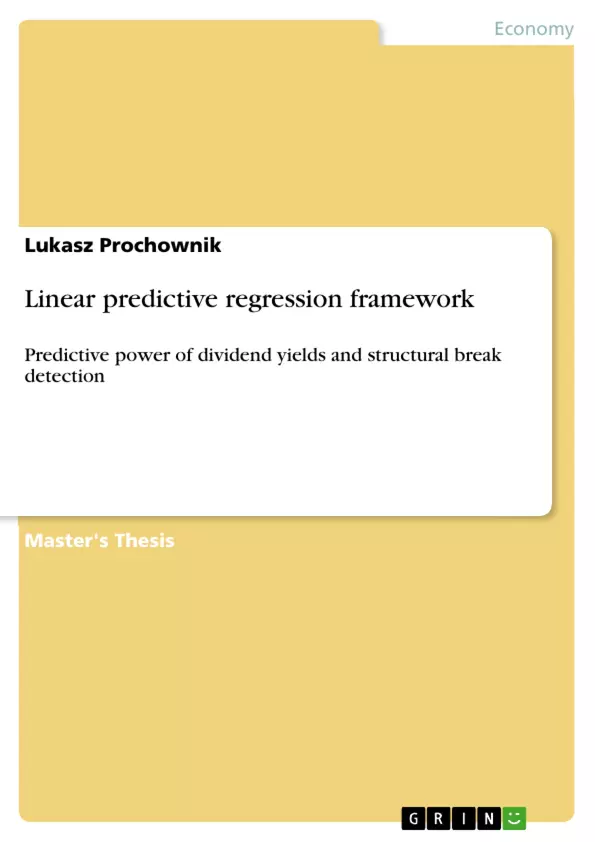The concept of predictive regressions has been studied for over the past 20 years and its application is particularly present in applied economics, finance and econometrics. The basic set-up in the predictive regression framework associates the noisy explained variable with the lagged persistent regressor, which can be characterized as a process close to the unit root process. In my work I describe the relevance and implications of an adoption of the linear predictive regressions in forecasting the volatile stock return using the lagged variable, dividend-price ratio, which is highly persistent. Subsequently, I aim to answer questions whether the excess stock returns are predictable using dividend yields and whether the predictability is stable over time. The analysis I conduct, based on financial data, aim to detect the hypothetical presence of structural breaks in the model. In order to search for the structural instability of coefficients I construct a Wald test for each possible structural break location and investigate the accuracy of the SupWald statistic and its tabulated critical values in the framework described. Having obtained the test statistic for each of the possible break-points, I describe predictive power of explanatory variable and provide economic rationale to support some of the statistical outcomes.
Inhaltsverzeichnis (Table of Contents)
- Introduction
- Linear Predictive Regression Model
- Econometric Methodology and Hypothesis of Interest
- Empirical Results
- Economic Interpretation
- Conclusions
Zielsetzung und Themenschwerpunkte (Objectives and Key Themes)
This work explores the concept of predictive regressions and its application in forecasting stock returns using dividend yields. The main objective is to assess whether the predictive power of dividend yields is stable over time, particularly focusing on the presence of structural breaks. The study aims to determine if the excess stock returns are predictable using dividend yields and if this predictability is consistent over time. The analysis also seeks to identify potential structural breaks in the model and analyze their impact on predictive power.
- Predictive power of dividend yields on stock returns
- Structural stability of predictive regressions
- Impact of structural breaks on predictive power
- Econometric methodology for testing structural breaks
- Economic interpretation of empirical findings
Zusammenfassung der Kapitel (Chapter Summaries)
- Introduction: This chapter provides an overview of predictive regressions, their application in finance, and the limitations of existing studies in examining structural stability. It highlights the importance of investigating the potential presence of structural breaks and the need for robust methodology to identify and analyze them.
- Linear Predictive Regression Model: This chapter delves into the theoretical framework of linear predictive regression models, emphasizing their relevance in forecasting stock returns. It discusses the use of lagged persistent regressors, such as dividend yields, and the challenges associated with their estimation.
- Econometric Methodology and Hypothesis of Interest: This chapter introduces the econometric methodology used to test for structural breaks in the predictive regression model. It outlines the hypothesis of interest, focusing on the stability of the relationship between dividend yields and stock returns over time.
- Empirical Results: This chapter presents the empirical results obtained from the analysis. It examines the estimated coefficients of the predictive regression model, tests for structural breaks using appropriate statistical techniques, and analyzes the results.
- Economic Interpretation: This chapter interprets the empirical results in an economic context. It provides insights into the economic factors that may have contributed to the presence or absence of structural breaks and the implications for the predictability of stock returns.
Schlüsselwörter (Keywords)
The main keywords and focus topics of this work include linear predictive regressions, dividend yields, stock returns, structural breaks, Wald test, SupWald statistic, predictive power, financial markets, economic forecasting, and econometric methodology.
- Citar trabajo
- Lukasz Prochownik (Autor), 2011, Linear predictive regression framework, Múnich, GRIN Verlag, https://www.grin.com/document/182493



